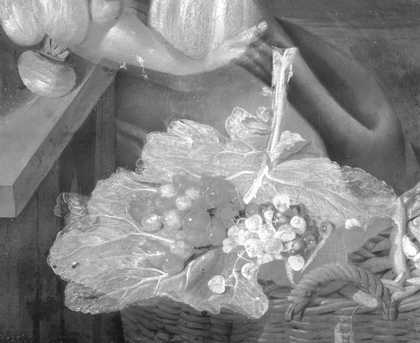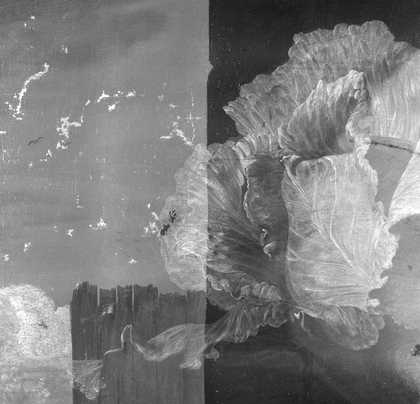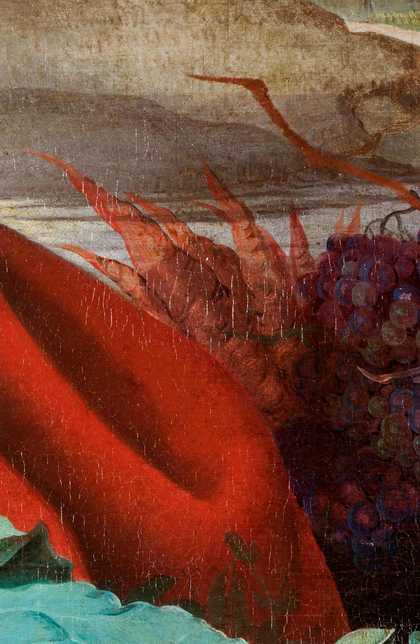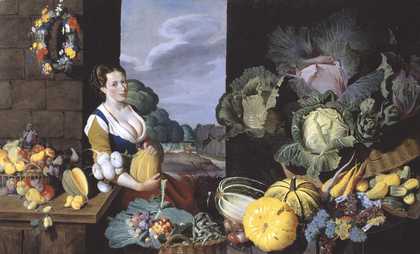
Fig.1
Nathaniel Bacon 1585–1627
Cookmaid with Still Life of Vegetables and Fruit c.1620−5
Oil paint on canvas
1510 x 2475 mm
T06995
This painting is in oil paint on canvas measuring 1510 x 2475 mm (fig.1). The support is a single piece of very fine, plain-woven linen. It has 15 vertical threads and 17 horizontal threads per square centimetre. Cusping of the weave around the edges indicates that it was primed as a single piece on a strainer or stretcher that has not survived (fig.2). When acquired by Tate in 1995 the lined painting was attached to an adjustable pine stretcher. The style of this stretcher and of the lining (linen canvas with red lead in oil as the adhesive) suggested an origin in the late eighteenth century, although the use of red lead as the lining adhesive would be unusual at any time. The stretcher was slightly smaller than the original would have been; the ground and the painted design strayed over onto its tacking edges on the top, bottom and left sides.

Fig.2
X-radiograph of Cookmaid with Still Life of Vegetables and Fruit
The mushroom coloured ground is oil based and is composed of a mixture of lead white, fine black and a few orange and red earth particles.1 On top of this there is pale grey, opaque priming, which is composed of white lead with charcoal and bone black, pipeclay, and traces of chalk or gypsum (fig.3). Its surface is smooth.
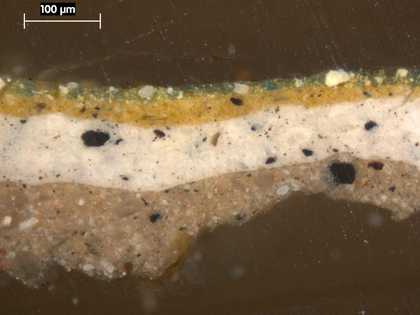
Fig.3
Cross-section through a melon, photographed at x225 magnification, showing (from bottom to top): mushroom coloured ground; grey priming; yellow of melon skin; green stripe on skin
No underdrawing is visible with the unaided eye or infrared. Cross-sections and surface examination indicate an additive or sequential style of painting. The cabbage leaves, for example, were first laid in with opaque bluish tones composed of smalt, azurite and red lake. The deep shadows were added on top with a mixture containing azurite, red lake, vermilion and black; the highlights with pale green mixed from azurite, lead tin yellow and smalt. Finally thin glazes of red lake or red lake mixed with azurite were applied here and there (fig.4). The purplish blue grapes at the bottom edge were laid in with opaque grey paint, then glazed all over with semi-translucent purplish red before the opaque blue paint was applied selectively on top (fig.5).
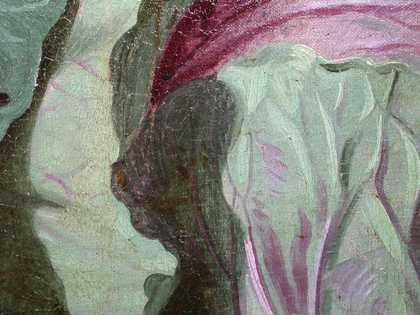
Fig.4
Macro-photograph of cabbage leaf, showing sequential application of details and glazes
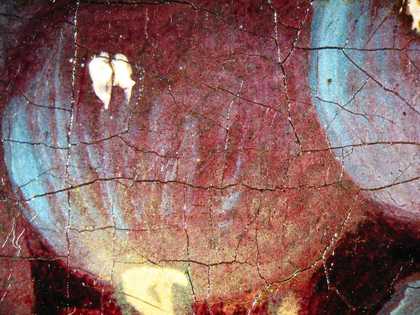
Fig.5
Micro-photograph of purple grape
The sharp interfaces between the layers in the cross-sections indicate that all layers were touch-dry before further paint was applied (figs.6 and 7).

Fig.6
Cross-section through purple grape, photographed at x225 magnification, showing (from bottom to top): mushroom-coloured ground; grey priming; purple paint of the grape’s skin; blue paint of the bloom on the grape’s skin
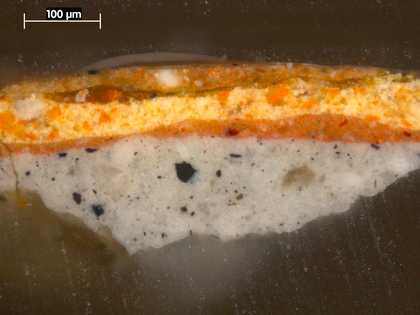
Fig.7
Cross-section through yellow pear, photographed at x225 magnification, showing (from bottom to top): opaque pale grey priming, average 80 microns thick; opaque dark orangey red paint, average 20 microns thick; bright opaque orangey yellow paint, average 35 microns thick; thin layer of unpigmented varnish, which fluoresces bright white in ultraviolet light; opaque orange paint, average 25 microns thick
This additive process applies also to the way the composition evolved: small elements were applied on top of fully painted larger elements. The main features of the picture – the wall, figure, doorway, garden, table and the pile of cabbages – were put in first and painted completely. Then smaller elements were applied on top; with the passage of time some of the underlying paint schemes have become more visible (figs.8 and 9). For example, the dark root vegetables (skirrits) in the centre next to the cookmaid’s skirt were painted entirely on top of the background garden (fig.10), and underlying phases of paint can be seen in the onions hanging out of the barrel in the right foreground. This method of building up the painting is evident in other ‘cookmaid’ paintings by Bacon and also in his full length Self Portrait of c.1620 in a private collection.2 This is not the way the majority of professionally trained painters would have gone about their work in this period; it was better technical practice and also more economical to leave unpainted reserves for the smaller elements when constructing the main parts of the composition. It suggests that this gentleman painter had received little training from professionals.
The range of pigments is fairly restricted. Azurite mixed with lead white was used for the cookmaid’s blue bodice, with smalt and black added for the shadows. The sky is a mixture of white lead and smalt. The bright yellow of the melons and other fruit is lead-tin yellow. The sixteenth-century miniaturist and writer Edward Norgate tells us in his bookMiniatura of 1627−8 that Bacon made his own yellow lake (‘pinke’) from the plant Dyers’ Broom and analysis of this painting showed that Bacon used this pigment mixed with ochres and azurite to make the greens of the distant foliage, and also on its own as a top glaze.3 The dye was fixed to a substrate containing calcium, aluminium and sulphur, as related in the recipe. The red plant dye in the red lake is cochineal, almost certainly from the New World. It is possible that the painting has undergone some fading. Cross-sections from the sky and from the blue grapes suggest that there has been some degradation of the smalt, and examination of the red skirt suggests it was originally glazed with red lake.
After acquisition by Tate the painting was cleaned and restored in 2001. The old lining was removed during this treatment and replaced with a strip-lining, a loose lining and a new stretcher that reinstates the original dimensions.
July 2004

